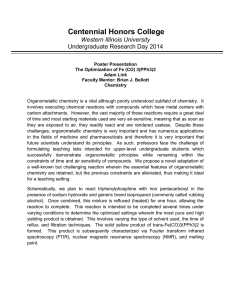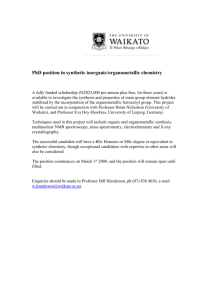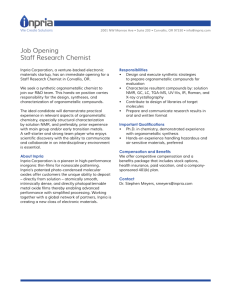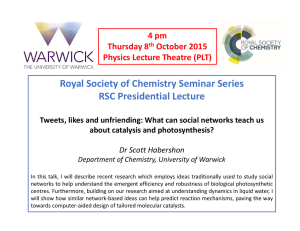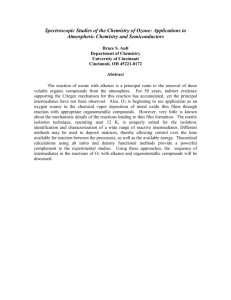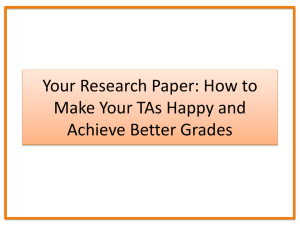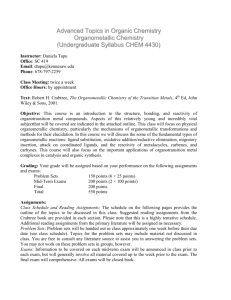CHEM 462
advertisement
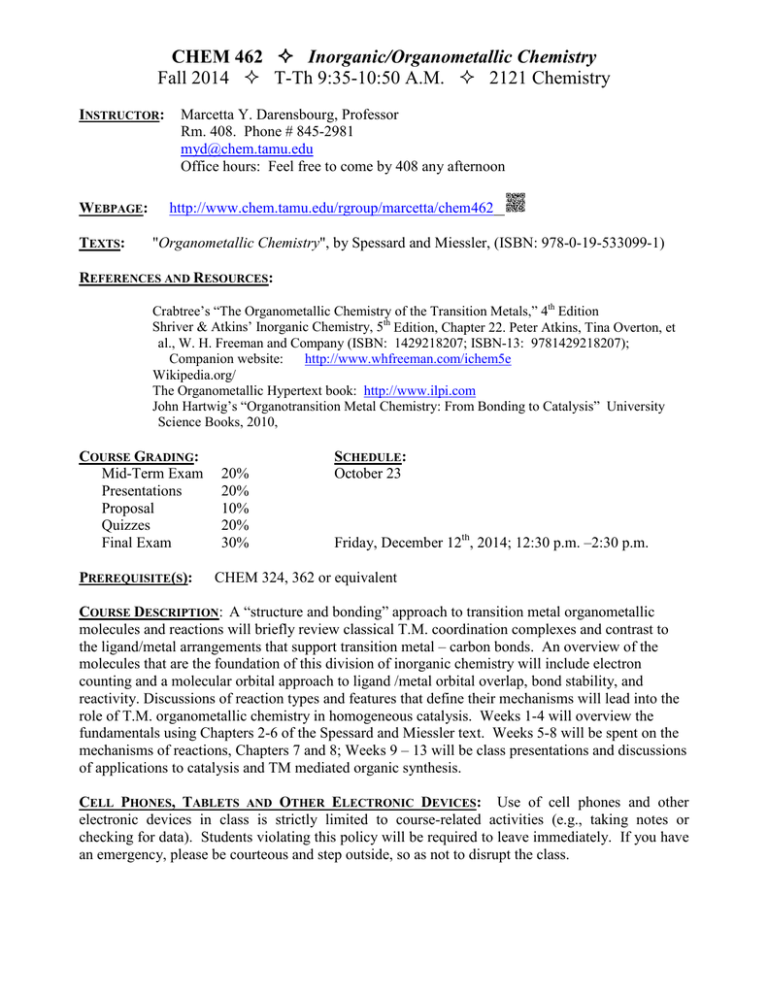
CHEM 462 Inorganic/Organometallic Chemistry Fall 2014 T-Th 9:35-10:50 A.M. 2121 Chemistry INSTRUCTOR: WEBPAGE: TEXTS: Marcetta Y. Darensbourg, Professor Rm. 408. Phone # 845-2981 myd@chem.tamu.edu Office hours: Feel free to come by 408 any afternoon http://www.chem.tamu.edu/rgroup/marcetta/chem462 "Organometallic Chemistry", by Spessard and Miessler, (ISBN: 978-0-19-533099-1) REFERENCES AND RESOURCES: Crabtree’s “The Organometallic Chemistry of the Transition Metals,” 4th Edition Shriver & Atkins’ Inorganic Chemistry, 5th Edition, Chapter 22. Peter Atkins, Tina Overton, et al., W. H. Freeman and Company (ISBN: 1429218207; ISBN-13: 9781429218207); Companion website: http://www.whfreeman.com/ichem5e Wikipedia.org/ The Organometallic Hypertext book: http://www.ilpi.com John Hartwig’s “Organotransition Metal Chemistry: From Bonding to Catalysis” University Science Books, 2010, COURSE GRADING: Mid-Term Exam Presentations Proposal Quizzes Final Exam PREREQUISITE(S): 20% 20% 10% 20% 30% SCHEDULE: October 23 Friday, December 12th, 2014; 12:30 p.m. –2:30 p.m. CHEM 324, 362 or equivalent COURSE DESCRIPTION: A “structure and bonding” approach to transition metal organometallic molecules and reactions will briefly review classical T.M. coordination complexes and contrast to the ligand/metal arrangements that support transition metal – carbon bonds. An overview of the molecules that are the foundation of this division of inorganic chemistry will include electron counting and a molecular orbital approach to ligand /metal orbital overlap, bond stability, and reactivity. Discussions of reaction types and features that define their mechanisms will lead into the role of T.M. organometallic chemistry in homogeneous catalysis. Weeks 1-4 will overview the fundamentals using Chapters 2-6 of the Spessard and Miessler text. Weeks 5-8 will be spent on the mechanisms of reactions, Chapters 7 and 8; Weeks 9 – 13 will be class presentations and discussions of applications to catalysis and TM mediated organic synthesis. CELL PHONES, TABLETS AND OTHER ELECTRONIC DEVICES: Use of cell phones and other electronic devices in class is strictly limited to course-related activities (e.g., taking notes or checking for data). Students violating this policy will be required to leave immediately. If you have an emergency, please be courteous and step outside, so as not to disrupt the class. CHEM 462 – Fall 2014 – pg. 2 LEARNING OUTCOMES: On completion of the course, the student should be able to • Predict the structures and electron counts of an organometallic complex comprised of a particular set of ligands and transition metal ion. • Classify organometallic reactions and products according to the primary reaction types. • Identify major catalytic applications of transition metal organometallic chemistry. • Research literature, prepare presentation (ca. 25 ppt slides) and present a topic within homogeneous, transition metal organometallic catalysis. • Identify an outstanding problem in such catalysis or organometallic chemistry related to such catalysis and prepare a research proposal based on this problem. (ca. 4 pages; template provided) • Use ChemDraw or ChemSketch for describing structures in 3-dimensions. CHEMDRAW: For questions requiring chemical structure drawing, use the chemical drawing program, ChemDraw. ChemDraw is the program used by almost organic chemists to prepare manuscripts for publication. This program is available on the computers at the Student Computing Center; alternatively you can purchase your own copy for $36 through https://software.tamu.edu/public/AvailableSoftware.aspx?Page=1. ADA STATEMENT: The Americans with Disabilities Act (ADA) is a federal anti-discrimination statute that provides comprehensive civil rights protection for persons with disabilities. Among other things, this legislation requires that all students with disabilities be guaranteed a learning environment that provides for reasonable accommodation of their disabilities. If you believe you have a disability requiring an accommodation, please contact the Department of Student Life, Services for Students with Disabilities, in Room 126 of the Koldus Building or call 845-1637. AGGIE HONOR CODE: “An Aggie does not lie, cheat, or steal or tolerate those who do.” Upon accepting admission to Texas A&M University, a student immediately assumes a commitment to uphold the Honor Code, to accept responsibility for learning, and to follow the philosophy and rules of the Honor System. Students will be required to state their commitment on examinations, research papers, and other academic work. Ignorance of the rules does not exclude any member of the TAMU community from the requirements or the processes of the Honor System. For additional information please visit: www.tamu.edu/aggiehonor/ CHEM 462 – Fall 2014 – pg. 3 Student Presentation Guidelines • From list provided, give 1st, 2nd, and 3rd choices. • Presentation date will be set by MYD—cannot be changed. • Research by first going to text books in syllabus. • Research secondly by going to key journal articles. • Present abstract, outline and sketch of slides to MYD 2 weeks prior to presentation • You should expect to need ca. 25 slides per presentation • You should identify fundamental organometallic chemistry that is at basis of your topic. • The first slide will be a ca. 200 word abstract of your topic. • Discussion Leaders – 5 minutes before the end of class the week and class period before presentation: o Introduce next topic o Suggest a reference to be read by the class prior to the next presentation o During the presentation => Lead discussion • The entire class should prepare a relevant well-considered question and come to class prepared to ask. The question should be typed up and submitted to the discussion leaders at the beginning of class. These questions will be randomly selected to be asked whenever the presentation/discussion is at a low point. • The presenters must have their presentations approved by MYD at least one week in advance of their presentation date. Student Original Research Proposals • This can be derived from your presentation of someone else’s. Must be from topics presented in CHEM 462-2014. • A template will be provided. • The figures from your proposal will be the basis of a second short presentation.
